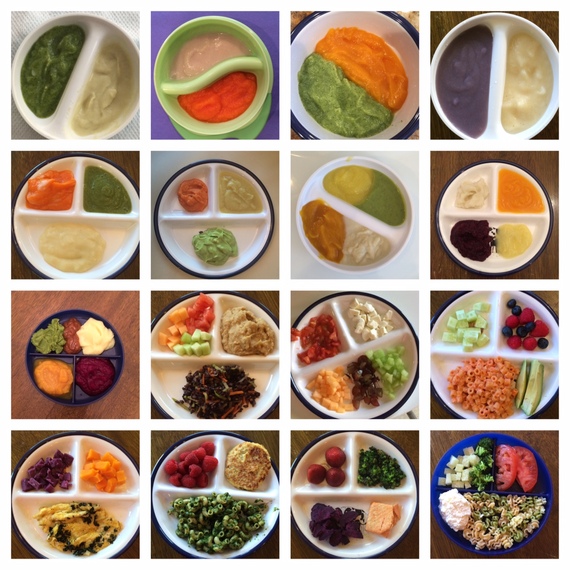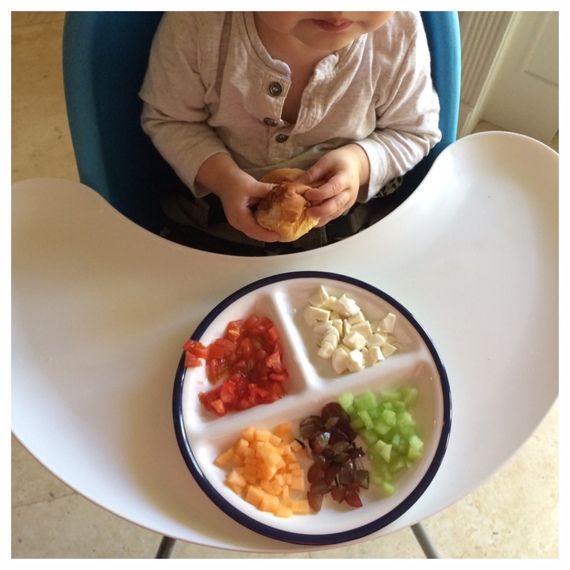What if children learned to love vegetables and unprocessed foods from the day they start eating? What if we did not have to convert our children's tastes with negotiations and entreaties? As parents we teach our children what is important to us whether it is what is right or wrong or saying please and thank you. Shouldn't we include eating habits as one of those critical life lessons?
In my medical practice where I focus as a nutrition specialist, I hear the following complaint often. "My child ate every single jar of vegetable baby food I offered, and then when I switched to real vegetables they stopped eating them." After finally hearing this one too many times, I realized that figuring out why babies stop eating their vegetables once they transition from jarred or pouch baby food to regular vegetables was worth trying to better understand.
As part of my research I came across an article published in Pediatrics called, "Prenatal and Postnatal Flavor Learning in Infants." (1) It described how fetuses taste flavors from their mother's diet in the amniotic fluid they swallow and babies in their breast milk. In this study, the researchers exposed mothers (pre- and post-partum) to different combinations of carrot juice and water, and then recorded the babies' facial expression behavior once they were fed carrot flavored cereal. The results of this study demonstrated that the infants who had exposure to the flavor of carrots in either amniotic fluid or breast milk exhibited significantly fewer "negative" facial expressions than did non-exposed control infants.
When I became pregnant with my daughter, I became very interested in my own prenatal nutrition and how I planned to feed my baby as a way to test this thesis -- that the subtle flavors in amniotic fluid and breast milk could influence babies taste preferences. If I fed my daughter the pureed versions of the fresh foods that I had eaten during my pregnancy and breastfeeding then logically she should prefer eating these foods. When the time came to start my daughter on puree, I first examined and tasted commercially-prepared jarred or pouch baby food. It did not look or taste the same as the food I was eating.
Once I saw the drastic difference between processed and fresh baby food, I developed and experimented with what we referred to in medical school as "behaviorism." (2)(3) It is an approach to understanding one's psychology based on an underlying assumption that when we are born our mind is a "tabula rasa" (a blank slate) and behavior is learned from the environment. While babies are born with an innate preference for sweet-tasting sustenance (4), my belief is that parents can foster a love of vegetables by properly conditioning them, or as I like to call it, "Palatetraining."
We learn new behaviors through various forms of conditioning. We condition our children to behave with various forms of positive and negative encouragement (feedback), teach them values and morals, or to address a child's temper tantrum, so why not apply conditioning to a baby's healthy eating habits, tastes, and preferences? If a baby sees and tastes fresh food repeatedly, can this approach result in a baby liking fresh foods instead of a baby who has been raised on processed food and therefore been conditioned to like processed foods?
My answer from my experimenting is a resounding yes. My "Palatetraining" method uses vegetable purees to simulate the different colors on a painter's "palette" to train the baby's anatomic "palate" and visual preferences to love the diverse taste, texture, and color of vegetables. It is a gentle conditioning technique for systematically acclimating a baby's brain and senses to the world of nutritious fresh foods, taking baby's delicate neurophysiology into consideration.
The best analogy to describe how babies react to the transition from processed baby food to fresh whole food reminds me of when Dorothy steps out of black and white Kansas into technicolor Oz. It is SENSORY OVERLOAD! Babies are not conditioned to handle these intense new stimuli, so they reject these new strange foods. We surely cannot expect babies to suddenly and happily transition to a new food environment of solids in whole form with complicated textures, smells, taste variation and vibrant colors after eating muted mushy foods for six months!
If you want your children to eat their vegetables, I must admit that there are no shortcuts. You have to start by making fresh baby and toddler food. It takes time, effort, and planning, but I promise you it is worth it! The time you invest now in feeding your baby simply prepared fresh foods will have an even greater return when you save yourself hours of time, money, and energy on food battles down the road.
Over the past year I have been documenting my 1-year-old son's "Palatetraining" on social media as he gobbles down fresh veggies. It is possible to raise a vegetable lover, you just have to start earlier and "Palatetrain" your child from their first bite of solids. We can truly begin to raise a new generation of kids who love vegetables and healthy eating.
My daughter is now 5 years old, and I can proudly say that she pops roasted Brussels sprouts into her mouth like popcorn and orders the salad bar option at camp. She is also the child at a birthday party who gravitates to the crudité platter usually served for adults while the pizza goes cold on her plate.
Our First Lady Michelle Obama's dedication to the "Let's Move -- America's Move to Raise a Healthier Generation of Kids" campaign is an important initiative to change the way a generation of parents and children think about food and nutrition. This campaign focuses on school age children, but if I could suggest -- what is missing is the most crucial and developmental period in a child's nutritional life... their very initial INTRODUCTION TO EATING VEGETABLES starting as infants. Instead of the typical bland, colorless diet of refined high-fat, high-carbohydrate processed foods, which has many negative consequences including contributing to pediatric obesity epidemic, I would ask Let's Move to take on exposing a baby's naïve tastes and senses to an environment of fresh diverse tastes, colors, aromas, and textures that will determine whether a child will transition to an ideal colorful, plant based healthy "Let's Move" diet.


